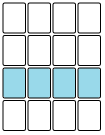
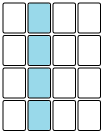
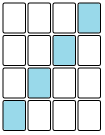
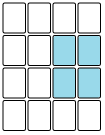
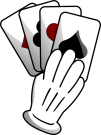
A card game for 2 players, © by Bill de Veas, 2020-01-25; last revised 2020-07-09
Two players compete to be the first to group or collect four matching cards.
This game uses a shuffled deck of 24 cards: All four A2345, + 2 Black Jacks, + 2 Red Queens.
You are advised to keep your hand hidden. However, since all cards are in play, each player can figure out their opponent’s hand by process of elimination anyway.
Your goal is to make 4 of a kind (called a “quad”), on the grid (by row, column, diagonals, or 2x2 square) or in your hand.





You accomplish this by moving cards in the grid, which can change your own hand and your opponent’s hand. More on this below.
The “pie rule” applies: After the first move, the second player may choose to either make a move (and remain the second player), OR completely swap with the first player, who then becomes the new second player and is eligible to make their new “first” move. (This means that if the first player’s very first move is a winning move, the second player can trade places and claim the win instead.)
Players take turns manipulating the grid by moving either a row (to the left or right) or a column (toward the opponent).
For example, to shift a row of cards to the right, the 4th-column card drops off the grid, the 3rd-column card moves to the 4th column, the 2nd-column card moves to the 3rd column, and the 1st-column card moves to the 2nd column.
Row Movement: Grid rows always wrap around when moved. That is, the card that drops off of a grid row gets placed in the gap on the opposite end.
Column Movement: You may only “push” a column toward your opponent, never “pull” a column toward yourself.
When you push a column, an exchange occurs:
If you attempt a move that immediately undoes/reverts your opponent's last move, your opponent may call you out for "backsies" and then may allow or disallow the move at their discretion.
Some examples of what would be considered "backsies" include:
A player who can show that they have gained a quad by any of the means stated above (1x4, 2x2, or in-hand) ends the game.
The simplest, basic way to score is just to give 1 win to anyone who has gained a quad when the game ends.
There is a more detailed scoring system available, however.
Scoring rules:
Players should mutually decide on the terms of winning a series of games before play begins.
Suggested terms: The winner is whoever reaches a score of at least 40 or causes the other player to score -32 or lower.
With this additional rule, when you move a row (never a column), you may play a null card from your hand into the gap in exchange for the card that drops off the opposite end. For example, given a row of [5♥, A♦, 2♣, 3♣], a player can place a null card ([J♠]) on the left, slide the row to the right, and claim the [3♣] into their own hand, leaving the row to look like [J♠, 5♥, A♦, 2♣].
This change, which makes the null cards uniquely useful while off the grid, was suggested by a playtester as a way to alleviate the boring scenario of players passing a single null card back and forth during consecutive column moves. It also grants each player a way to take a card for their self, rather than relying completely on being given cards by the opponent. The cards in both outer columns are vulnerable to being taken in this way.
This additional rule introduces a little bit of hidden information and luck, so that the game is no longer one of perfect information.
Setup: Add another set of four matching number cards, such as the four "8"s.
Deal the grid as before, and deal three face-down hands of four cards each. The dealer's opponent picks one of the three hands, then the dealer picks one. The remaining hand is set off to one side, still face-down.
(Note that players' hands can no longer be perfectly deduced.)
New Move: On your turn, you may instead choose at random a face-down card from the "third hand" (e.g., your opponent shuffles the hand and offers it to you) and play it into a row, face down. Turn over the card that drops off the opposite end and put it into the third hand. Then, reveal the new card on the grid.
(Alternatively, if you have a d6 die, you could lay the four "third hand" cards in a row and roll to determine which one to choose — e.g., 1-4 identifies a card position, 5 means you can choose any card, and on 6 you re-roll, but if your re-roll is also a 6, you fail and must do something else with your turn.)
This may be one of those games that’s “easy to learn, hard to master”. When I'm teaching the game to a new player, typically I'll coach them gently at first, show them my hand whenever they ask to see it, dialogue with them about their thought process and mine, and let them reconsider/take back a move, until they get the hang of it.
The base game (with no variants) is a game of “perfect information” — like Chess and Go — and, as such, it exhibits the same inherent issue that those deterministic games have: they can devolve into uncapped “look-ahead contests”, where the prospect of winning starts to be determined by one's ability to explore more of the possibility space.
So far, every time I’ve taught this game to someone in person, their first few games were quick and casual, but further games would noticeably slow down and intensify, as the players would start to think two or more moves ahead and try to predict their opponent’s moves. This game is not kind to over-thinkers for that reason — but winning can be so rewarding.
Sometimes, when I play against an experienced opponent, I set a short timer for myself and just move wherever looks best if it goes off.
2020-06-15: Added 'Side Swipe' variant rule.
2020-07-09: Added the 'Backsies' rule, which had just been informal etiquette before.